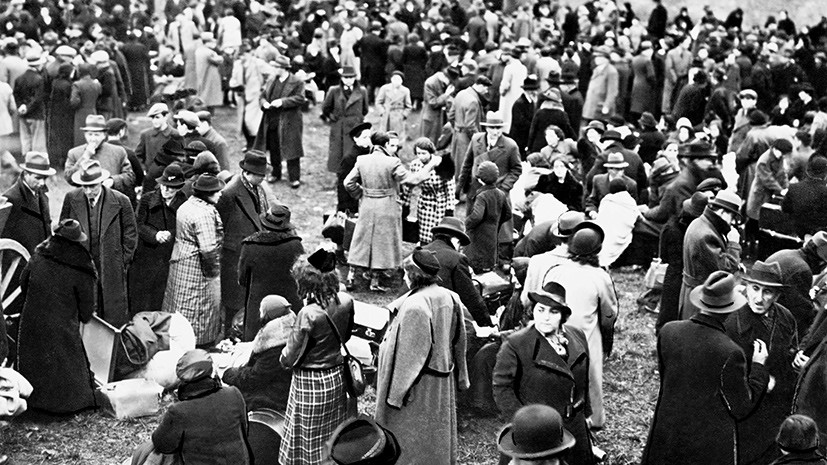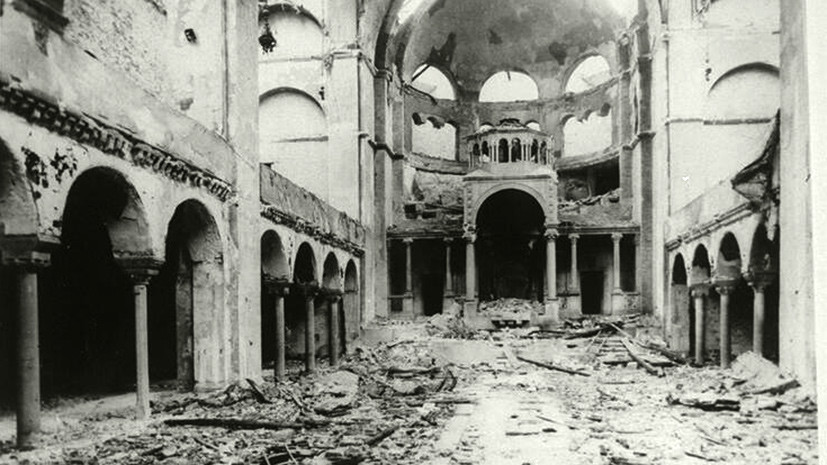In the mid-1930s, after Hitler came to power, on the initiative of the Nazis, the Third Reich began to enact laws that deprive Jews of their citizenship, the right to be in the civil service, work in medicine, education and law, enter into marriages with “Aryans”. Over 500,000 German Jews were ousted from social and political life and were unable to influence the situation in the country in any way. However, the Nazis were not going to stop there. Their plans included completely clearing the territory of the Third Reich from the Jewish population. True, there were discussions among the Hitlerite functionaries regarding the specific ways of achieving this goal.
“One of the most active supporters of public violence against Jews was Julius Streicher, who even by the standards of the Nazis was considered an odious person. However, Hitler favored him because of his personal merits that took place as early as the 1920s, ”the writer and historian Konstantin Zalessky told RT in an interview.
Streicher, a schoolteacher and participant in the First World War, who received officer shoulder straps at the front, was the founder of the ultra-right German Socialist Party, which in 1922 joined the Nazi NSDAP. During the failed Beer Putsch, Streicher walked alongside Hitler on the march to the headquarters of the ground forces and did not abandon him when the attack aircraft engaged in a firefight with the police. Hitler appreciated the loyalty of a fellow party member. In 1923, Streicher was commissioned to publish the Nazi newspaper Der Stürmer, and in 1925 he became the Gauleiter of Nuremberg.
He was suspected of seducing minors, he was fond of pornography, humiliated the husbands of his many mistresses and did not hide his sadistic inclinations. However, due to Hitler’s personal disposition, his position in the party and country was strong for a long time. On the pages of Der Sturmer, the most basest ethnic hatred was inflaming, anti-Semitic pornographic cartoons and incitement to violence were published. In 1938, Streicher’s ideas concerning targeted persecution of the Jews (in particular, boycotting their shops), found support from the Nazi führer.
Formal occasion
In 1938, the Polish authorities also drafted and adopted regulations that significantly restricted the rights of Jews. According to the law of March 31, Polish citizens who lived abroad for more than five years lost their citizenship. The same measures were taken in respect of those who lived abroad for less than five years, but did not have time to present their Polish passport to the consulate for replacement from October 15 to October 30, 1938.
This was a painful blow to the tens of thousands of Polish Jews who worked in various European countries in the first half of the twentieth century. The situation was complicated by the fact that many immigrants from Poland managed to obtain German citizenship, but were deprived of it because of the laws adopted by the Nazis, restricting Jewish citizens in their rights.

- Zbonshinsky expulsion. Deported on the parade ground of the old military barracks. October 29, 1938
- © Wikipedia
After waiting for October 28, the Nazis made a brutal provocation: they forcibly loaded 20 thousand Polish Jews into trains and took them to the border. Poland has closed the border for its former citizens. People were locked in a neutral zone without livelihoods. Only after lengthy consultations, the official Warsaw agreed to let about 4,000 of its former citizens cross the border. Poland refused to accept the rest of the deportees, and they became prisoners of Nazi concentration camps.
Among the victims of the deportation was the family of 17-year-old Herschel Grynszpan, a Jewish youth, who at that time lived with his uncle in France. Upon learning of what had happened, he wrote a farewell letter to his parents, containing the following words: “My heart sank with blood when I learned about your fate, and I must protest so that the whole world would know about it.” Then he went to the German embassy and fired five times from a revolver at the secretary of the German diplomatic mission Ernst Rath.
It is worth noting that fom Rath, despite his membership in the NSDAP and the assault detachments, was homosexual, was often treated for venereal diseases among Jewish doctors and was not at all distinguished by Nazi fundamentalism. Gryshrpan also rotated in non-traditional sexual orientation circles. This gave rise to rumors that Grinshpun’s actions could have been the result of a personal spat between lovers, or a provocation by Hitler’s intelligence services, who simultaneously found a way to provoke a massive attack of hatred against Jews and get rid of a diplomat with an uncomfortable biography.

- Herschel Feibel Grinshpan's arrest and Ernst Edward vom Rath (right)
- © Scherl / globallookpress.com; Wikipedia
Konstantin Zalessky evaluates such assumptions skeptically.
“There is no direct documentary evidence of the personal acquaintance of Grinshpan and Fom Rath. There are only indirect arguments that some authors cite. However, if this is true, then why write a letter and shoot at the embassy instead of somewhere else? ”He notes.
The version about the provocation of the Nazi special services, according to the historian, looks unconvincing. “It should be understood that the Third Reich at that time was not a well-functioning state. There was a chaos of competence, each pulling a blanket over himself. The chief of the SD, Reinhard Heydrich, had previously made several unsuccessful provocations abroad, for which his chief, Heinrich Himmler, very much received from Hitler. The leadership of the Reich advised the SS not to go into international affairs at all. Against this background, rumors that the Grynszapan’s shots were a Heydrich-led initiative sound quite unconvincing, ”said Konstantin Zalessky.
Despite the number of bullets fired at him, Phom Rath did not die immediately - even Hitler’s personal doctor Karl Brandt left Berlin to take part in his treatment. However, according to one version, due to the severity of the injuries, and on the other - due to an unsuccessful blood transfusion, the diplomat died.
Crystal night
Developing the ideas of Streicher, the Reich Minister of Public Education and Propaganda Joseph Goebbels suggested that Hitler use the death of Rath to incite mass hatred of Jews in society. The Fuhrer agreed. On November 7, articles appeared in the Nazi party press accusing Jews of allegedly “killing German diplomats, rejoicing in their synagogues and controlling entire sectors in the German economy.”
On November 9, during the events dedicated to the anniversary of the suppression of the “Beer Putsch”, Goebbels said: “The National Socialist Party will not be humiliated to organize attacks against the Jews. But if a wave of popular indignation hits the enemies of the Reich, neither the police nor the army will interfere. ”
The words of the main propagandist of the Third Reich served as a signal for the Nazi activists. Disguised as civilian clothing, members of the assault detachments and the Hitler Youth started Jewish riots in Germany, Austria and the Sudetenland.

- Burnt synagogue in Berlin
- © Center for Jewish History, NYC Follow
“About a thousand synagogues were burned that night in full view of everyone, including firefighters, who were ordered to intervene only in the event of the threat of spreading fire to buildings near the synagogues. The attackers and members of the Hitler Jugend looted and smashed the windows of approximately 7,500 stores owned by Jews, which is why they began to call it Crystal Night.
In many areas, Jewish cemeteries were the target of abuse. Berlin and Vienna, the cities where the two most numerous Jewish communities lived, were seriously destroyed. Crowds of SA militants hung about the streets, attacking Jewish houses and exposing Jews to public humiliation, ”said Dmitry Surzhik, a methodologist at the Victory Museum, in an interview with RT.
Many Jews were killed during the pogroms, but the exact death toll is unknown. We are talking about at least 91 attacks with a fatal outcome. About 30 thousand Jews were arrested and imprisoned, and then sent to concentration camps. About 2,000 of them were almost immediately beaten to death by warders.
International reaction
“The SS leadership was initially skeptical of the idea of mass Jewish pogroms. Not out of philanthropy, of course. First, the police were against any element of uncontrollable violence on the streets. Secondly, the SS considered that the “solution of the Jewish question” should take place quietly and unnoticed, without attracting the attention of the international community. Thirdly, the pogroms in any case damaged the reputation of official Berlin, ”said Konstantin Zalessky.
At the same time, he said, the reaction of foreign authorities to Kristallnacht was not very expressive. “The US recalled the ambassador for consultations, some other governments expressed regret. However, no one really wanted to really help the Jews, to host the refugees. In most European countries, anti-Semitic sentiments were extremely strong. Ships with Jewish refugees came to one port after another, but were forced to turn back. Someone from public figures will say later that the states of Europe in the first half of the twentieth century were divided into two categories: those from whom Jews were expelled, and those who did not want to accept them, ”said the historian.
According to the academician of the Academy of Political Sciences of the Russian Federation, the head of the department of the PRUE. G.V. Plekhanov Andrei Koshkin, Crystal Night was the prologue to the Holocaust and a signal of preparation for the mass destruction of the Jewish people. The political elites of many foreign countries in 1938 realized that the fate of the German Jews would be tragic, but did not want to help the victims of Nazism.
